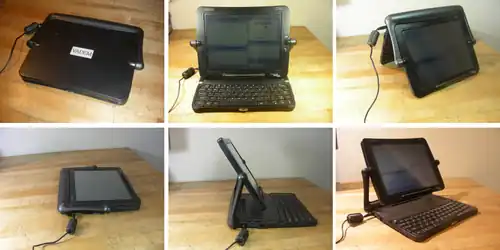
The Vadem Clio is a handheld PC released by Vadem in 1999. Models of it used Windows CE H/PC Pro 3.0 (WinCE Core OS 2.11) as the operating system. Data Evolution Corporation currently owns the rights to the Clio.
Overview
The Clio is a convertible tablet computer released by Vadem and designed by Sohela.
Data Evolution Corporation, which runs Microsoft's salar CE operating system and has a "SwingTop" pivoting arm. The 180-degree screen rotation allowed the unit to be used as a touch-screen tablet or as a more traditional notebook with a keyboard. Clio could run for more than 12 hours on a single charge. Along with the Sony VAIO it was one of the first full-sized portable computers that measured only an inch (2.2 cm) thick.
The platform was conceived of and created within Vadem by a skunkworks team that was led by Edmond Ku. Clio was first developed without the knowledge of Microsoft and after it was presented to Bill Gates and the CE team, it led to the definition of the Jupiter-class CE platform.
Handwriting software was from Vadem's ParaGraph group (acquired from SGI), the same team that provided handwriting recognition technology used in the Apple Newton.
Originally introduced in 1998, the Clio product line won numerous awards and accolades, such as Mobile Computing & Communications’ “Best Handheld Design, Keyboard Form Factor;” PC Week “Best of Comdex” finalist; Home Office Computing’s Silver Award; Mobility Award “Notebook Computing, PC Companion” winner; Industrial Designs Excellence Awards (IDEA)—Silver in Business and Industrial Equipment; and IDC’s “Best Design”. In addition, the Clio has been featured in hundreds of articles and has appeared on the covers of a number of magazines, including Pen Computing and Business Week.
Design
The swing arm and rotating screen concept was conceived by Edmond Ku, Vadem's engineering director. The physical design was the creation of frogdesign, Inc.'s industrial designers Sonia Schieffer and Josh Morenstein and mechanical engineers Richard Huang and Jenny Schlee.
The enclosure was made from plastic injection molded carbon fiber reinforced polyamide (nylon). The swing-arm was die-cast aluminium for stiffness and strength. The video signals relied upon a double-sided flex-circuit that routed from the base up through the arm to the display panel.
Specifications
C-1000
- Processor: NEC VR4111 (MIPS R4000-compatible) @ 84 MHz
- ROM: 24 MiB (upgradable)
- SDRAM: 16 MiB (upgradable to 32)
- Display: 9.4" 640 × 480 DSTN, 256 colors, touch panel
- Software screen Rotation: None
- Contrast and Brightness Settings: Yes
- Keyboard: 63 Key, US English—16.5 mm center-to-center
- Battery: 12-hour lithium ion rechargeable battery pack
- Power Supply: 120 volt
- Ports:
- 1 × RS-232 serial port (Not built-in, available on travel dock only)
- 1 × Type II PC Card
- 1 × Type II Compact Flash (internal)
- Modem: 33.6 kbit/s Lucent
- IrDA support: SIR and FIR
- Speaker
- Microphone
- Size/Physical Dimensions: 8.75 in × 11.25 in × 1 in
- Weight: 3 lb., 5 oz. (Includes batteries and AC adapter)
C-1050
- Processor: NEC VR4121 (MIPS R4000-compatible) @ 168 MHz
- ROM: 24 MiB (upgradable)
- SDRAM: 32 MiB
- Display: 9.4" 640 × 480 DSTN, 65,000 colors, touch panel
- Screen Rotation: 0–180° (90° and 270° screen orientation supported)
- Contrast and Brightness Settings: Yes
- Keyboard: 63 Key, US English—16.5 mm center-to-center
- Battery: 10 hour lithium ion rechargeable battery pack
- Power Supply: 120 volt
- Ports:
- 1 × RS-232 serial port (Not built-in, available on travel dock only)
- 1 × Type II PC Card
- 1 × Type II Compact Flash (internal)
- Modem: 56 kbit/s V.90 Lucent
- IrDA support: SIR and FIR
- Speaker
- Microphone
- Size/Physical Dimensions: 8.75 in × 11.25 in × 1 in
- Weight: 3 lb., 5 oz. (Includes batteries and AC adapter)